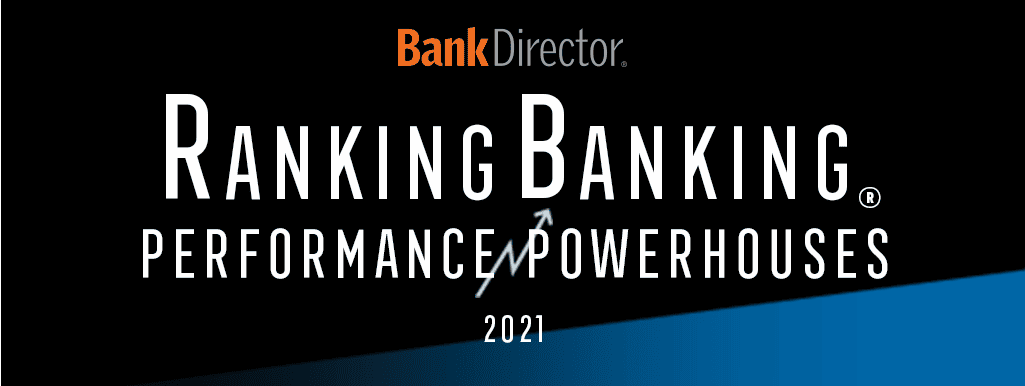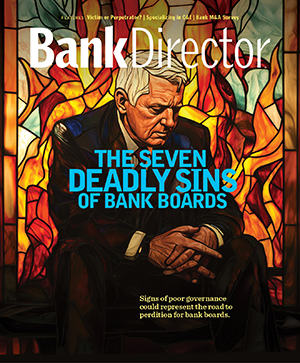
2021 RankingBanking: Performance Powerhouses
There’s nothing like an economic downturn to win full appreciation for a company’s commitment to long-term performance and its adherence to a strategic North Star.
With this in mind, Bank Director’s 2021 RankingBanking study, sponsored by Crowe LLP, identifies banks that have built enviable value for their shareholders to uncover the building blocks of long-term performance. These high-performing banks were selected based on total shareholder return generated over a 20-year period ending June 30, 2020.
The resulting list of banks yields varying business models and strengths, sizes and geographies. Some are rural, some skew urban, and some operate national platforms. The smallest banks are $948 million First Capital, based in Corydon, Indiana, and $938 million Auburn National Bancorp., in Auburn, Alabama. The largest are $33.2 billion Prosperity Bancshares and Little Rock, Arkansas-based Bank OZK, with $26.9 billion in assets. Three banks are located in Texas: Prosperity, based in Houston, First Financial Bankshares in Abilene, and Southside Bancshares, in Tyler.
What all these banks have in common is a track record for successfully managing their institutions through economic cycles. We examined them across 10 categories to dig into their strategic strengths. These are:
“The categories are all components of a well-rounded bank,” says Crowe Partner Kara Baldwin. “Through time, certain metrics become in vogue, but performance ultimately boils down to producing consistently strong earnings for your shareholders on a long-term basis.” Critical to that is balancing organic and acquisitive growth, effective capital management, a strong credit culture, attracting and retaining talented employees, and today, understanding customer demands in a digital economy.
For each category, Bank Director sourced quantitative data from S&P Global Market Intelligence, company filings and other publicly available information. All told, more than 150 data points factored into our analysis, with the data spanning a five-year time period, from December 2014 to December 2019 — a date selected to avoid the muddiness of the pandemic environment. We also built case studies to better understand each bank’s performance, from its reputation as an employer to its technology strategy.
An algorithm was developed for each category; data points were ranked, with the lower score indicating the better performance. We then averaged the category scores to determine the overall winner. Total shareholder return was only used to identify the top 20 performance powerhouses and didn’t factor further into the ranking.
Bank OZK generated the highest 20-year total shareholder return, at 3,142%, and came out on top in the ranking. It didn’t win any of the categories outright but performed exceptionally well across the board, landing in the top 10 in every category. It scored in the top five for creating value, efficiency, risk, lending, technology and growth, as well as its ranking as an employer and the strength of its board.
Much of OZK’s performance today derives from how it positioned itself to take advantage of the last financial crisis, explains Piper Sandler Cos. managing director Stephen Scouten. The bank grew its real estate specialties group, a geographically diverse book of high-yield commercial loans, during that time; it also participated in seven FDIC-assisted deals in 2010-11 and bought some distressed bonds.
“They had exponentially better returns due to their more aggressive pursuits at the bottom of the crisis,” says Scouten.
Janney Montgomery Scott’s Brian Martin finds the bank well positioned for today’s downturn. “[C]redit is excellent, profitability is strong, and the bank is accumulating capital and building reserves,” he wrote in an October 2020 note.
“We have built an extraordinary bank, with an extraordinary team of people and a great business model,” says Bank OZK Chairman and CEO George Gleason. “I think it will prove to be very durable and very profitable over a long period of time.”
Coming in second, $13.2 billion Independent Bank Corp. operates through its commercial bank subsidiary, Rockland Trust Co. It generated a 867% TSR. The Rockland, Massachusetts-based bank, which has been recognized by the Human Rights Campaign for LGBTQ workplace equality, won the Best Employer category. It also scored in the top five for its strategy around revenue, retail, technology and growth.
Michigan City, Indiana-based Horizon Bancorp ranks third overall. The $5.8 billion bank, which generated a TSR of 1,185%, ranked second in the Best Board category, and in the top five for lending, revenue and technology.
Horizon’s footprint in business-friendly Indiana and Michigan provides a strong foundation, says Chairman and CEO Craig Dwight. From there, managers and employees are encouraged to proactively seek growth opportunities. “The windows of opportunity open and shut quickly,” he says. “You have to listen for opportunities; you have to be assertive.”
At fourth, $13.8 billion WSFS Financial Corp. is the only bank to win two categories: Best Board and Best Technology Strategy.
The board’s long-term focus directly impacts investments like WSFS’ digital transformation initiative, says Chairman and CEO Rodger Levenson. “The pandemic for us has just confirmed and accelerated everything that we’ve seen over the last few years,” he says. “[T]he longer-term trends have only been validated and … reinforced the strategic direction that we embarked upon before the pandemic.”
The Wilmington, Delaware-based bank also scored second for its revenue strategy and in the top five in the retail category. It generated a 886% TSR.
Sioux Falls, South Dakota-based Meta Financial Group ranks fifth. The $6.1 billion bank, which operates a unique business model heavy in prepaid cards, won the revenue strategy category due in large part to its ability to grow fee income and overall revenue. It earned a place in the top five in the lending and technology categories, and has the lowest TSR, at 749%.
At sixth, First Financial Bankshares won the Best Bank for Creating Value category. The $10.6 billion bank generated the second-highest TSR, at 2,074%, and ranked in the top five for its retail strategy.
First Financial “is one of the top franchises in our universe given its high level of capital, strong [pre-provision net revenue] and conservative balance sheet, which all represent untapped earnings power potential,” wrote Brad Milsaps, a managing director at Piper Sandler, in an October 2020 note.
Warsaw, Indiana-based Lakeland Financial Corp. ranks seventh. The $5.6 billion bank earned second place for its growth strategy, due in part to its high level of profitability growth and its diverse revenue streams. It also has a top-five showing for creating shareholder value and efficiency. Lakeland generated the fifth-highest TSR, at 1,960%.
Glacier Bancorp, based in Kalispell, Montana, ranks eighth, and scored in the top five for creating value, its lending strategy and its reputation as an employer. The $17.9 billion bank generated a 1,201% TSR.
Glacier is “among the best in the industry partly based on its consistent profitability profile, conservative credit culture and ability to use small bank M&A … to enhance EPS over time,” wrote Piper Sandler managing director Matthew Clark in October.
Southside Bancshares ranks ninth. The $7.2 billion bank’s consistently high profitability earned it second place for creating value; it also landed in the top five in the Best Employer and Best Board categories. It generated a 1,212% TSR.
In tenth place, DeWitt, New York-based Community Bank System won the retail category and ranked in the top five for its attributes as an employer and its strategy around credit risk. The $13.9 billion bank generated a TSR of 912%.
CEO Mark Tryniski believes performance starts and ends with culture. That includes treating people well and building a company that employees are proud to work for. “That, to me, is the secret,” he says. “Building the cultural organization and values is of critical importance in terms of sustainable performance.”
Rounding out the category winners, Eagle Bancorp Montana, based in Helena, Montana, ranks 11th overall and won the lending category based on loan growth, profitability and loan health. The $1.3 billion bank generated a 1,056% TSR, the same as $2.5 billion Southern Missouri Bancorp, which ranks 16th overall. The Poplar Bluff, Missouri-based bank won the growth category due to strong profitability growth and its successful track record for low-cost deals.
Hingham Institution for Savings, with $2.7 billion in assets, ranks 13th overall and was identified as the Most Efficient Bank; its efficiency ratio was a low 30.26% as of December 2019. The Hingham, Massachusetts-based bank generated a 1,966% TSR. And Auburn National, with its low net charge-offs, won the credit risk category. It ranks 20th overall and generated a 785% TSR.
Finally, 12th-ranked Stock Yards Bancorp, based in Louisville, Kentucky, generated a TSR of 901%; 14th-ranked Prosperity Bancshares had a 936% TSR. Catskill, New York-based Greene County Bancorp, ranks 15th and generated a 1,694% TSR; 17th-ranked First Capital had a 845% TSR; 18th-ranked The First Bancorp, based in Damariscotta, Maine, generated a 818% TSR; and Charleston, West Virginia-based City Holding Co. ranks 19th, with a TSR of 1,968%.
The banking industry has experienced rapid change due to the Covid-19 pandemic, and the next year promises more. There’s a high degree of uncertainty, particularly around credit risk.
“I would love to see how these top banks are doing come December 2020 or March 2021 in terms of their levels of charge-offs,” says Baldwin. “Does that historical discipline help them get through this pandemic?”
The performance powerhouses exhibit a long history of solid performance. What will the next few years bring?
How The Top Performers Ranked
| SCORE | ASSET SIZE (MILLIONS) | TICKER | |||
| OVERALL WINNER: Bank OZK | 7.30 | $26,888 | OZK | ||
|---|---|---|---|---|---|
| 2 | Independent Bank Corp. | 8.50 | $13,174 | INDB | |
| 3 | Horizon Bancorp | 8.80 | $5,790 | HBNC | |
| 4 | WSFS Financial Corp. | 9.17 | $13,830 | WSFS | |
| 5 | Meta Financial Group | 9.24 | $6,092 | CASH | |
| 6 | First Financial Bankshares | 9.35 | $10,568 | FFIN | |
| 7 | Lakeland Financial Corp. | 9.44 | $5,551 | LKFN | |
| 8 | Glacier Bancorp | 9.65 | $17,926 | GBCI | |
| 9 | Southside Bancshares | 9.66 | $7,191 | SBSI | |
| 10 | Community Bank System | 9.96 | $13,845 | CBU | |
| 11 | Eagle Bancorp Montana | 10.23 | $1,255 | EBMT | |
| 12 | Stock Yards Bancorp | 10.36 | $4,365 | SYBT | |
| 13 | Hingham Institution for Savings | 10.91 | $2,719 | HIFS | |
| 14 | Prosperity Bancshares | 11.06 | $33,198 | PB | |
| 15 | Greene County Bancorp | 11.14 | $1,799 | GCBC | |
| 16 | Southern Missouri Bancorp | 11.32 | $2,541 | SMBC | |
| 17 | First Capital | 11.55 | $948 | FCAP | |
| 18 | The First Bancorp | 12.15 | $2,267 | FNLC | |
| 19 | City Holding Co. | 12.65 | $5,511 | CHCO | |
| 20 | Auburn National Bancorp. | 12.71 | $938 | AUBN | |




